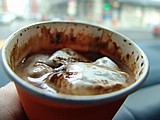Home |
Restaurants by City
|
Food Photography |
Archive | Philosophy |
![]()
Right now we are eating in Seattle, Washington.
|
Monday
2004
Permalink
|
Jacques Torres Chocolate, New York, NY, tasted on February 21, 2004 I'm a big fan of hot chocolate, and not just when it's snowing out. Frankly, I think hot chocolate should become a year round beverage. As someone who still hasn't found a way to like coffee (no matter how much sugar and cream I pour in there) I have another reason to want hot chocolate -something to drink when everyone else is drinking coffee. When I heard that there was a spot in Brooklyn, a self-styled "chocolate factory" created by Jacques Torres, former pastry chef at Le Cirque, I knew we had to make a stop there. Sure enough, our first stop that day was at Jacques Torres Chocolate. While there were a zillion chocolate treats (I didn't see a chocolate river) we were there for one reason, and one reason alone. A perfect hot chocolate is almost like a heated chocolate milkshake. Thick, frothy, creamy, velvety smooth, with a chocolate depth that feels light because of the infusion of air and cream (whipped or otherwise). There are those that like their hot chocolate a little more rustic. I enjoy that as well, and Jacques Torres' hot chocolate fell more into that category. It was slightly bitter (in a good way) with consistent thickness and not overly thick or muddy. That said, it was still like drinking a bar of rich dark South American chocolate. I could have finished it with time, but it would have taken awhile. I'm usually a fan of a slightly sweeter hot chocolate, and this bordered on the Mexican. It was very very good. We also got the spicy variety. At first you think the spices only make their presence felt in the aroma. But a few moments after you drink some then it sets a tiny faint fire in your mouth on the finish that lasts and lasts. A little late, but better than never we noticed a bowl of homemade marshmallows sitting on the counter. Homemade marshmallows. Who makes their own marshmallows? Jacques Torres does. Letting that melt into our drinks gave them a candied quality. They were so thick and rich that they didn't just disappear, they floated and melted for some time. Deep, rich hot chocolate, with complex flavors, and homemade marshmallows. Not a bad way to start our day in New York.
|
|||
Our Sponsors
Online Loans Conversion Strategies College Courses Surprise Birthdays Online Trading - Calendar and Event Schedules - Food Events and Calendars - Wine Events and Calendars - Digital Photography Resources - Jewish Gifts and Judaica - Howard Stern Podcast ponytailed blogger Jonathan Schwartz

Browse tastingmenu
Home |
Restaurants by City X |
Food Photography |
Archive | Philosophy |
![]()
Free eBooks: All About Apples
| Autumn Omakase
More:
Discussion |
Cool Food T-Shirts |
Ingredients
| Markets |
Recipes
Search |
Blog FAQ |
Other
Blogs
Best of tastingmenu
|
City View
Entry: July 6, 2006 |
Blue Plate
Entry: June 19, 2006 |
L'Atelier de Joël Robuchon
Entry: July 18, 2006 |
Browse by City
Boston | Chicago | Houston | Las Vegas | Los Angeles | Maui | New York | Philadelphia | Portland | San Francisco | Seattle | Toronto | Utah | Vancouver | Washington D.C.
Bangkok | Beijing | Hong Kong | Seoul | Tokyo
Amsterdam | Berlin | Italy | London | Madrid | Paris | Vienna
Browse by Month
2006
2005
2004
2003
2002
2001
Comments, questions, or feedback:
info / at / tastingmenu / dot / com
All pages Copyright (c) 2001-2006 tastingmenu.com
Last modified 11/27/06.




